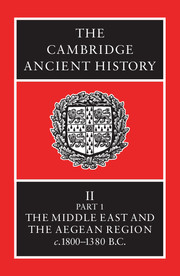Book contents
- Frontmatter
- Contents
- List of Maps
- List of Tables
- List of Text-figures
- Preface
- CHAPTER I NORTHERN MESOPOTAMIA AND SYRIA
- CHAPTER II EGYPT: FROM THE DEATH OF AMMENEMES III TO SEQENENRE II
- CHAPTER III PALESTINE IN THE MIDDLE BRONZE AGE
- CHAPTER IV
- CHAPTER V HAMMURABI AND THE END OF HIS DYNASTY
- CHAPTER VI ANATOLIA c. 1750–1600 B.C.
- CHAPTER VII PERSIA c. 1800–1550 B.C.
- CHAPTER VIII EGYPT: FROM THE EXPULSION OF THE HYKSOS TO AMENOPHIS I
- CHAPTER IX EGYPT: INTERNAL AFFAIRS FROM TUTHMOSIS I TO THE DEATH OF AMENOPHIS III
- CHAPTER X SYRIA c. 1550–1400 B.C.
- CHAPTER XI PALESTINE IN THE TIME OF THE EIGHTEENTH DYNASTY
- CHAPTER XII THE ZENITH OF MINOAN CIVILIZATION
- CHAPTER XIII THE LINEAR SCRIPTS AND THE TABLETS AS HISTORICAL DOCUMENTS
- CHAPTER XIV THE RISE OF MYCENAEAN CIVILIZATION
- CHAPTER XV ANATOLIA c. 1600–1380 b.c.
- CHAPTER XVI THE ARCHAEOLOGICAL EVIDENCE OF THE SECOND MILLENNIUM B.C. ON THE PERSIAN PLATEAU
- BIBLIOGRAPHIES
- Chronological Tables
- Index to Maps
- General Index
- Map 1: Greece and the Aegean Islands in the Middle Bronze Age.
- Map 3: Babylonia and Western Persia.
- Fig. 7. Plan of the Palace at Cnossus.
- Map 6: Ancient Asia Minor and Northern mesopotamia
- References
CHAPTER XIII - THE LINEAR SCRIPTS AND THE TABLETS AS HISTORICAL DOCUMENTS
Published online by Cambridge University Press: 28 March 2008
- Frontmatter
- Contents
- List of Maps
- List of Tables
- List of Text-figures
- Preface
- CHAPTER I NORTHERN MESOPOTAMIA AND SYRIA
- CHAPTER II EGYPT: FROM THE DEATH OF AMMENEMES III TO SEQENENRE II
- CHAPTER III PALESTINE IN THE MIDDLE BRONZE AGE
- CHAPTER IV
- CHAPTER V HAMMURABI AND THE END OF HIS DYNASTY
- CHAPTER VI ANATOLIA c. 1750–1600 B.C.
- CHAPTER VII PERSIA c. 1800–1550 B.C.
- CHAPTER VIII EGYPT: FROM THE EXPULSION OF THE HYKSOS TO AMENOPHIS I
- CHAPTER IX EGYPT: INTERNAL AFFAIRS FROM TUTHMOSIS I TO THE DEATH OF AMENOPHIS III
- CHAPTER X SYRIA c. 1550–1400 B.C.
- CHAPTER XI PALESTINE IN THE TIME OF THE EIGHTEENTH DYNASTY
- CHAPTER XII THE ZENITH OF MINOAN CIVILIZATION
- CHAPTER XIII THE LINEAR SCRIPTS AND THE TABLETS AS HISTORICAL DOCUMENTS
- CHAPTER XIV THE RISE OF MYCENAEAN CIVILIZATION
- CHAPTER XV ANATOLIA c. 1600–1380 b.c.
- CHAPTER XVI THE ARCHAEOLOGICAL EVIDENCE OF THE SECOND MILLENNIUM B.C. ON THE PERSIAN PLATEAU
- BIBLIOGRAPHIES
- Chronological Tables
- Index to Maps
- General Index
- Map 1: Greece and the Aegean Islands in the Middle Bronze Age.
- Map 3: Babylonia and Western Persia.
- Fig. 7. Plan of the Palace at Cnossus.
- Map 6: Ancient Asia Minor and Northern mesopotamia
- References
Summary
ISOLATION OF MINOAN–MYCENAEAN LITERACY
If some fairly high degree of literacy, and at least a modest production of literature, are to be expected in an original and in other respects notable culture, such as the Minoan in its great days, then the Minoan culture must be considered odd. As with all peoples before a certain measure of literacy is attained, doubtless there was ‘oral literature’, but about Minoan oral compositions nothing much can be inferred. When at length writing had been learned, at least writing for some purposes, the writing down of creative literature seems not to have been one of the purposes. Of written literature, indeed, not one scrap survives, nor is there any evidence pointing to the existence of any written literature. Oral compositions may well have been common right down to the end. Certainly there was no high degree of literacy.
For the understanding of this, many necessary facts are known only partially, and many more are lost. Theory too is weak. About literacy itself, generally, as a phenomenon, knowledge is rudimentary. There is no published study that has both scope and value. We know little of what to expect, how to understand. This is particularly true of the earlier stages. Until enough is known so that sharp delimitations are possible, it seems best to include a wide range of graphic expression and communication.
Information
- Type
- Chapter
- Information
- The Cambridge Ancient History , pp. 582 - 626Publisher: Cambridge University PressPrint publication year: 1973
